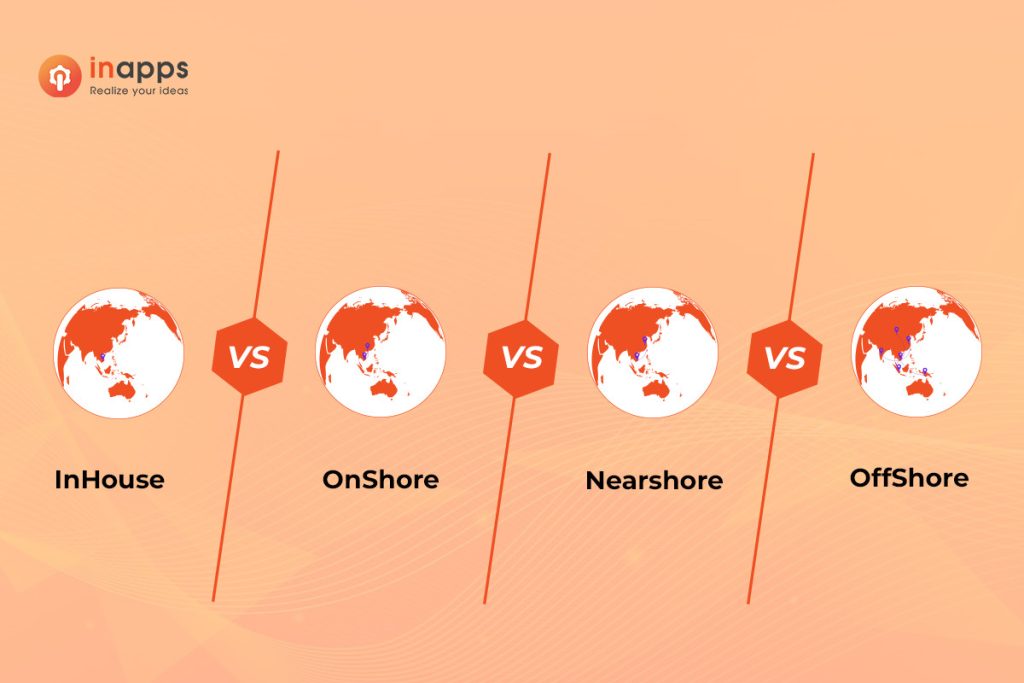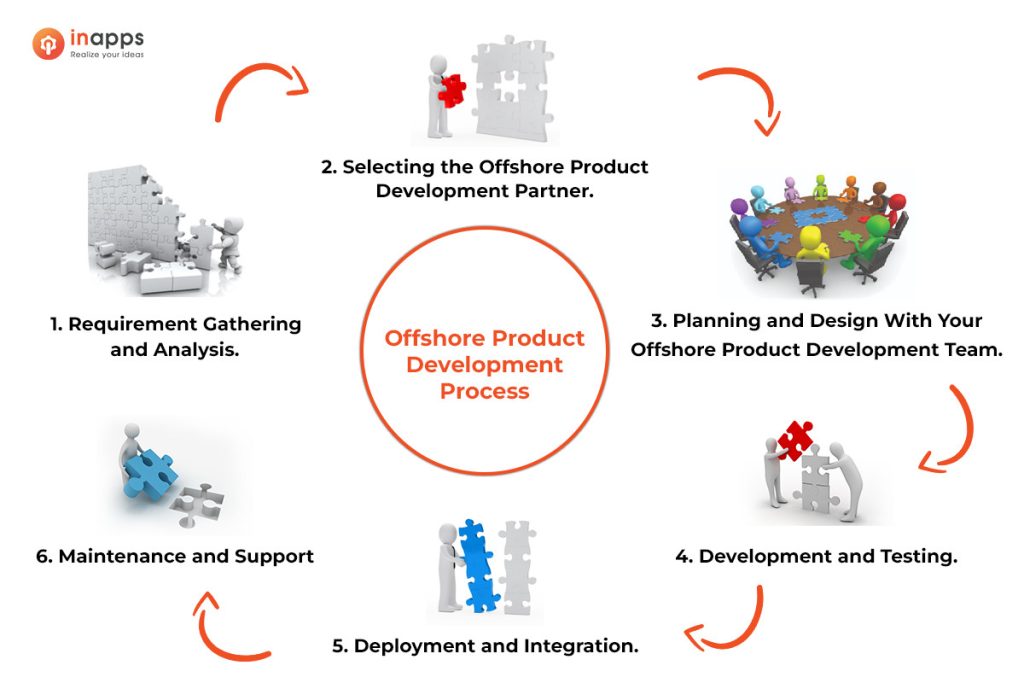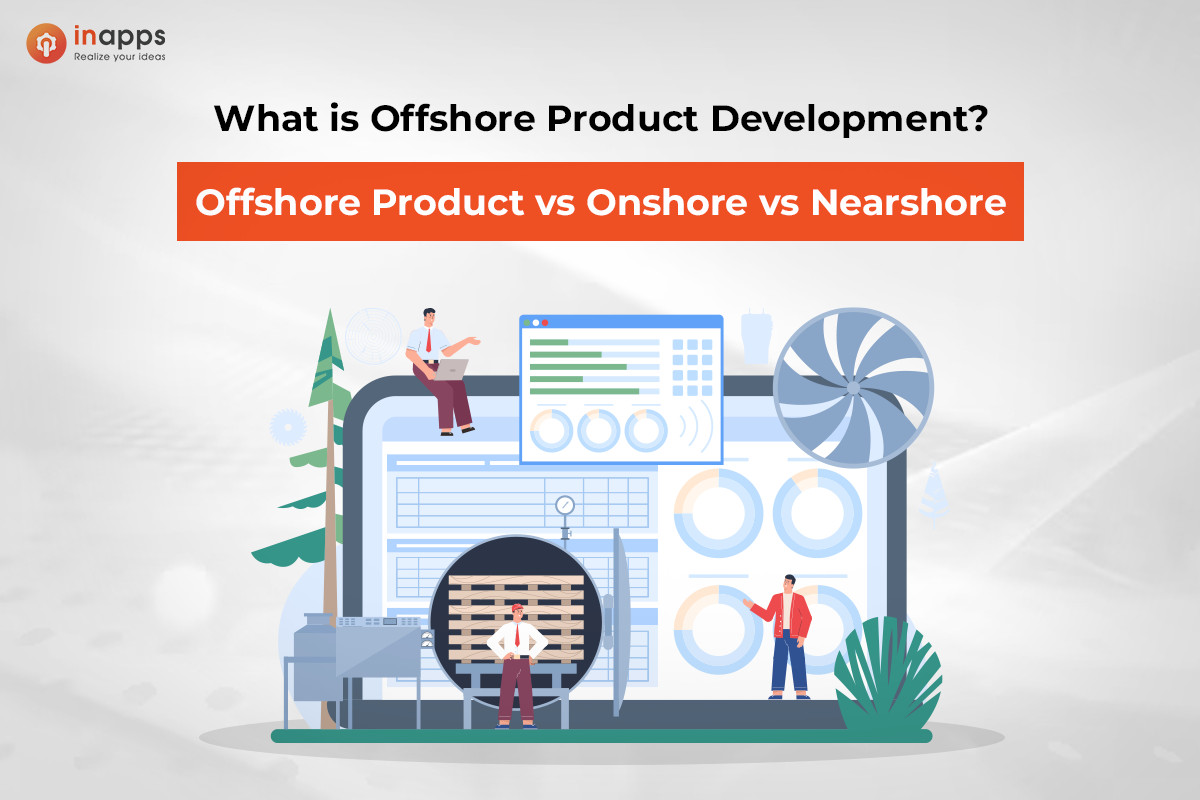- Home
- >
- Offshore News
- >
- Offshore Product Development and How It Differs?
Offshore product development is becoming increasingly popular among companies looking to save costs and access specialized skills. According to the 2023 Deloitte Global Shared Services and Outsourcing Survey, 51% of businesses move to new locations to lower costs, while 27% do so to tap into a broader talent pool.
In this blog, we will explore what offshore product development is, compare it with other outsourcing models, and discuss its benefits and risks. You’ll also get a step-by-step guide on the offshore development process, helping you understand how to succeed in this strategy.
By the end of this blog, you’ll understand offshore product development and be better equipped to take the next step. Now, let’s dive in!
1. What is offshore product development?
Offshore product development is the practice of partnering with an offshore software development company located in different countries to design, develop, and maintain software products. This strategy leverages the cost benefits, specialized skills, and round-the-clock productivity that come from working with global talent pools.
In simpler terms, it’s like hiring an offshore team from another country to help build your software products, often at a lower cost and with access to unique expertise. For example, a tech company in the U.S. needs to develop a new mobile app. Instead of hiring local developers, they might partner with a team in Vietnam. This Vietnamese team will handle the coding, testing, and maintenance of the app while collaborating closely with the U.S in-house.
Offshore product development services typically entail the following core services:
- Product Design and Prototyping
- Software Development
- Quality Assurance and Testing
- Product Maintenance and Support
2. Offshore product development vs other types of outsourcing

Here is a summary table showing the differences between offshore product development and other types of outsourcing, including in-house, onshore, and nearshore.
| Factor | Offshore
Product Development |
Onshore
Product Development |
Nearshore
Product Development |
In-house
Product Development |
|---|---|---|---|---|
| Location | Different countries | Same country | Nearby countries | Within the organization |
| Cost Savings | High | Low | Moderate | None (high costs) |
| Talent Access | Broad, specialized skills | Limited to the local market | Good, regional expertise | Limited to hires |
| Time Zones | Significant differences | Same or similar | Minimal differences | N/A (same location) |
| Examples | Asia, Eastern Europe | Hiring local firms | U.S. to Mexico, Western Europe to Eastern Europe | Internal teams |
| Benefits | – Cost efficiency
– Access to niche skills – Round-the-clock development |
– Easier communication
– Cultural alignment – Quick in-person meetings |
– Balance of cost and communication
– Easier collaboration – Shorter travel distances |
– Complete control
– Immediate communication – Strong company culture |
All in all, we’ve come to conclusions:
Offshore product development saves you money, gives you access to specialized skills, and time zone benefits. When companies partner with teams in countries like Asia or Eastern Europe, they can significantly cut labor costs. They also tap into a broader pool of talent with niche expertise. Plus, different time zones can mean round-the-clock work, speeding up project timelines.
Onshore and nearshore development, however, offer easier communication and cultural alignment but at higher costs. Nearshore development means collaborating with nearby countries. Nearshore is like a middle ground with moderate cost savings and easier coordination. Meanwhile, onshore development involves outsourcing to development teams within the same country, easy for quick meetings but expensive.
In-house development provides the most control and integration with company culture but is the costliest due to salaries, benefits, and infrastructure.
3. Benefits of offshore product development
3.1 Cost Efficiency
Offshore teams, particularly in regions like Asia or Eastern Europe, often offer high-quality services at significantly lower rates than their onshore counterparts. According to the 2023 Deloitte Global Shared Services and Outsourcing Survey, most respondents indicated they relocated to new locations to achieve lower costs (51%) and to gain better access to talent (27%). This rings true because there is a huge gap between the average hourly rate for software developers in the U.S ($110-$170), and in Vietnam where it ranges from $20-$60.
3.2 Access to Expertise
According to multiple industry reports, many offshore product development destinations are known for their specialized technical skills. For example, Eastern Europe, particularly countries like Poland and Ukraine, is renowned for its software engineering talent. These countries consistently rank high in surveys like the Stack Overflow Developer Survey and the HackerRank Developer Skills Report.
Meanwhile, India excels in IT services and advanced technologies. Reports from NASSCOM and Deloitte’s Global Outsourcing Survey emphasize India’s leadership in fields such as AI, machine learning, and mobile app development, thanks to its large pool of experienced professionals.
3.3 24/7 Productivity
With offshore product development teams spread across different time zones, companies can achieve round-the-clock development cycles, speeding up time-to-market. This model allows for continuous progress on projects, with teams handing off work at the end of their day to colleagues in another time zone. A 2023 study by McKinsey & Company reported that companies utilizing global teams experience a 25-35% increase in project speed due to this continuous workflow.
3.4 Scalability
Offshore development allows companies to easily scale their teams up or down based on project needs without the long-term commitments of hiring local staff. This flexibility is particularly beneficial for startups and businesses with fluctuating workloads. The 2023 Global Services Location Index by AT Kearney found that the ability to scale operations quickly is a key benefit of offshore development centers.
4. Risks of offshore product development
Offshore product development can bring many advantages, but it also comes with certain risks. Here are some key risks to help you navigate these challenges.
4.1 Communication Barriers
One significant risk in hiring an offshore product development team is communication barriers. Differences in language and time zones can lead to misunderstandings and delays. For example, a U.S. company working with a team in India might struggle with real-time communication due to the 9-12 hour time difference. This can delay responses and extend project timelines, so maintaining smooth and efficient operations can be a challenge.
4.2 Quality Control Issues
Another common issue is quality control. Maintaining consistent quality standards can be challenging when working with offshore teams. According to an Outsourcing Amid Complexity survey by Deloitte, 48% of companies faced quality issues in their offshore development projects.
For instance, a software bug might be overlooked due to different testing standards, leading to a product that doesn’t meet the original quality expectations. This can result in additional time and resources being spent on rework, ultimately increasing the overall project cost.
4.3 Data Security Concerns
Data security concerns are also prevalent in offshore product development. Protecting sensitive data can be challenging when it is handled by teams in different countries with varying data protection laws. According to Cost of a Data Breach Report 2023, the average cost of a data breach worldwide reached a record high of $4.45 million. This was a 2.25% increase from 2022, when the average cost was $4.35 million.
For example, a European company outsourcing development to a team in a country with less stringent data protection laws might risk exposing customer data. Then it is crucial for the offshore product development agency to first sign a GDPR (General Data Protection Regulation) compliance agreement.
In case you don’t know, The General Data Protection Regulation (GDPR) is a law in the European Union that protects people’s personal data. It sets rules for how companies must handle and protect this data, giving individuals more control over their information. For example, companies must get clear consent to use personal data, keep it secure, and allow people to access, correct, or delete their data.
4.4 Hidden Costs
Lastly, hidden costs can erode the financial benefits of offshore development. While initial costs may seem lower, hidden costs related to management, travel, and potential rework can add up. A study by Everest Group found that hidden costs can increase the total cost of offshore projects by 20-30%. For example, frequent trips to the offshore location for meetings and oversight can significantly increase the project’s overall cost, negating some of the anticipated savings.
In summary, while offshore product development offers cost savings and access to specialized skills, it is essential to be aware of and manage these risks. By addressing these challenges proactively, companies can fully leverage the benefits of offshore development while minimizing potential drawbacks.
5. Offshore product development process

The offshore product development process involves several steps and here’s a straightforward explanation of each step:
5.1. Requirement Gathering and Analysis
The first step is understanding what the project needs to achieve. You can list out the requirements of your product and send a Request for Proposal to your offshore team. Then, they’ll schedule an online meeting to discuss this further. After the meeting, the offshore team then analyzes this information to create a clear project plan.
For example, a U.S. company might want to hire a Vietnam team to build a new mobile app. In their RFP, they will explain the features and target audience of the app. If the client knows about software development, they may suggest the tech stacks in their RFP.

An RFP requesting offshore product development service
5.2. Selecting the Offshore Product Development Partner
Choosing the right offshore product development partner is crucial. You can start by searching “top offshore product development companies” on Google, or go over reputable listing platforms like Clutch to look for trusted partners.
The company will then evaluate different offshore teams based on their skills, previous work, and client feedback. One tip is to choose an offshore team that has done similar projects before and received great reviews about their work. After selecting a team, they sign contracts to ensure the offshore team will protect data according to laws like GDPR (if the client is in Europe).
5.3. Planning and Design With Your Offshore Product Development Team
Once the partner is selected, the next step is creating a detailed plan and design for the project. The offshore team develops a project timeline with key milestones and designs the app’s structure and appearance. They create wireframes and prototypes, which are then reviewed and approved by the company.
For example, the Vietnam product development team might design the app’s screens and features, and then share these designs with the U.S. company for feedback and approval.
5.4. Development and Testing
With the plan and design in place, the development phase begins. The offshore team writes the code and develops the app’s features. They conduct rigorous testing to identify and fix any problems. For instance, the Vietnam team builds the app and runs various tests to ensure all features work as planned and meet quality standards.
5.5. Deployment and Integration
After development and testing, the app is ready for deployment. The app is released to the public or deployed on servers. The offshore team ensures it integrates smoothly with any existing software or systems the company uses. For example, the app might be published on app stores, and the Vietnam team makes sure it works seamlessly with the U.S. company’s backend systems.
5.6. Maintenance and Support
The final step is providing ongoing support and maintenance to keep the app running smoothly and improve it over time. The offshore team monitors the app’s performance to spot any issues and implements updates to fix problems and add new features. For instance, the Vietnam team might provide continuous support, addressing bugs and releasing updates to enhance the app’s functionality.
6. How much does offshore product development cost?

6.1 Regional Cost Differences
Offshore developer’s rates vary significantly depending on the region. Here are some typical hourly rates based on geographical locations:
- Asia (India, Vietnam): $20-$60 per hour
- Eastern Europe (Poland, Ukraine): $20-$70 per hour
- Latin America (Brazil, Mexico): $30-$80 per hour
These rates are considerably lower compared to hiring developers in the U.S., where hourly rates range from $50 to $170.
6.2 Factors Affecting Offshore Product Development Cost
- Project Complexity
Basic apps with straightforward functionality and limited features tend to be less expensive (around $15,000-$30,000). Enterprise software or applications with advanced features, integrations, and custom functionalities will cost $50,000-$150,000 or more due to the increased development time and expertise required.
- Team Expertise
Less experienced developers charge lower rates ($20-$30) but might take longer to complete tasks. Meanwhile, more experienced developers and those with specialized skills charge higher rates ($50-$100) but bring efficiency and expertise to the project.
- Duration and Scope
Short-term, smaller projects or MVPs (Minimum Viable Products) are less expensive ($10,000-$50,000). Larger projects with extensive features and ongoing development will naturally incur higher costs ($100,000-$500,000).
- Additional Costs
When budgeting for offshore product development, it’s crucial to account for additional costs such as project management and communication. Travel expenses for necessary in-person meetings or oversight trips can also add up. Additionally, unexpected issues or changes in project scope can lead to potential rework. Planning for these expenses helps avoid financial surprises.
6.3 Example Offshore Product Development Cost Breakdown
This is one of our client requests “We are looking for an IT company to make home doctor applications.”, so let’s consider a medium-complexity doctor app developed over six months. Here’s an estimated cost breakdown based on 3 pricing models:
| Project-Based Rate (Medium Project) | Hourly Rates | Offshore Development Center (ODC) Rates |
|
|
|
|
Assuming the following team composition and hours:
Total Hourly Rate Cost: $73,920 Note: each member has a 40-hour work week; however, in reality, they may work less than 40 hours, so make sure to include buffer time. |
Assuming senior-level resources for higher quality:
Total ODC Cost: $67,500 |
7. Top offshore product development company in Vietnam
InApps Technology has firmly established itself as a premier offshore product development company in Vietnam, serving 300+ clients globally. Recognized by Clutch as the leading provider of application development and IT staff augmentation services in Vietnam, InApps is trusted by clients across North America, Europe, Australia, and the APAC region.

Top offshore product development company in Vietnam
Why Choose InApps Technology?
- Expert Offshore Product Team and Talent Pool
At InApps, we have an incredible team of over 100 in-house experts and access to a network of 500+ top talents. Our skilled developers are proficient in the latest technologies, from Java and .NET to ReactJS and Flutter. Whatever your project needs, we’ve got the expertise to make it happen.
- Proven Success Stories
With more than 200 successful projects and 70+ happy clients globally, we’ve proven our ability to deliver. Our portfolio spans various industries, including Edtech, Healthcare, SaaS, Ecommerce, Fintech, and Blockchain. From creating a comprehensive e-commerce platform for Trung Son Pharmacy to developing a smart contract platform for Vleppo, our track record speaks for itself.
- Wide Range of Services
We offer a full spectrum of services tailored to your needs:
- Offshore Development Center (ODC): We provide dedicated teams that integrate seamlessly with your in-house team for long-term projects.
- IT Staff Augmentation: Need specific expertise? We can fill those gaps with our top-notch talent.
- Custom App Development: We build bespoke applications that fit your unique business requirements.
- Enterprise Software Solutions: Our solutions streamline your business processes and boost efficiency.
- Flexible and Clear Engagement Models
We understand that every project is different. That’s why we offer flexible engagement models, whether it’s project-based, fixed-price, or a dedicated team setup. Plus, our pricing is transparent—no hidden costs. We keep you informed with detailed project scopes and timelines.
- Commitment to Quality and Security
Quality is at the heart of everything we do. We follow the highest standards in software development to ensure robust, secure, and scalable solutions. Our proactive project management and thorough quality assurance processes make sure we meet and exceed your expectations. And rest assured, your data security is our top priority.
- Happy Clients, Happy Us
We’re all about making our clients happy. With a 98% client retention rate and glowing testimonials, we’re committed to your satisfaction. We believe in building long-term partnerships and offer ongoing support and maintenance to keep your projects running smoothly.
Contact us!
Let’s create the next big thing together!
Coming together is a beginning. Keeping together is progress. Working together is success.




















